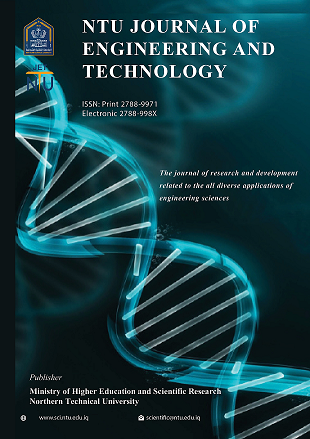Indicators of visual integration in urban development projects in the commercial markets in the city center of Erbil
DOI:
https://doi.org/10.56286/ntujet.v1i4.183Keywords:
integration, visual integration, urban development, commercial markets, urban scene.Abstract
The last decade was characterized by enormous urban development projects within the center of Erbil where commercial land use is dominant and it is represented by traditional markets or Bazaars. Neshtiman commercial complex is an example that has some distinguishing features in comparison with the adjacent traditional Bazaar.
The issue of visual integration in urban development is regarded as an essential matter which gives more positivity to the project and enhances the whole area. Urban masters had mentioned and established some indicators of the visual integration.
This paper tries to explore the visual integration indicators of the Neshtiman complex with its traditional surroundings in order to improve the existing situation and to obtain some guidelines that may be helpful in future development projects.
References
Al-Omari, Dr. Amal, (1982) "Markets and Construction in the Arab City through the Ages", Building World Magazine, No. 28.
Yousif, Dr. Mohsen Salahuddin. (1983) “The mental image of the city”. Summary of Kevin Lynch's book (The Image of the City 1960).
Al-Badrany, Saba Ibrahim, (1991) “The visual sense of form and the space of the commercial street”. Department of Architecture, University of Technology, Baghdad.
Hussein. Mohammed Mahdi. Dr. Ibrahim Jawad Al Yusuf. (2008) “Urban integration in the historical centers - an analytical study of the factors of urban integration between the old and the new in the urban structure of the historic center of Karkh”. University of Technology. Baghdad.
Hussein, Dhia Ali, (2012) "Visual enrichment in the urban landscape", Department of Architecture. Baghdad University. Baghdad.
Al-Mada newspaper, (2013 ) “Erbil boasts of its citadel and the old Qaysari market”. https://almadapaper.net/view.php?cat=81832
Al-Mousawi, Ahmed Hussein. Dr. Asma Niazi Taher. (2015) “The role of formal characteristics in the harmony of the urban landscape - the city of Najaf Al-Ashraf, a case study”. University of Technology-Department of Architecture-Iraq/Baghdad.
Al-Qaisi, Atheer Imran Hayawi. Dr. Abdul-Hussein Abdul Ali Al-Askari. ( 2016) "Visual Integration of Historic City Centers - Al-Rasheed Street". University of Baghdad - Urban and Regional Planning Center for Graduate Studies.
Al-Dewachi, Prof. Mumtaz Hazim Daoud. ( 2019) “Contextual integration in urban development projects”. Department of Architecture/ College of Engineering/ University of Mosul.
Lynch, Kevin, (1960) “the image of the city”. M.I.T press &Harvard University press.
Cullen; Gordon. ( 2007) “townscape”, Urban design reader book, Edited by Matthew Carmona & Steve Tiesdell. First edition. (1961)
Scott, W.A. Remicheal Wenheiner (1976) “Introduction to psychological research” Newyork, vietesty.
Rapoport A. (1977) “Human Aspects of Urban Form, Towards A Man-Environment Approach to Urban Form and Design”, Pergamon Press, Oxford, U.K.
Rush, D. Richard. (1986) “The Building Integration Handbook”. The American Institute oof Architects. USA.
Broadbent G. (1990) “Emerging concepts in urban space design”. John Wiley& Sons, London.
Ching F. (1996) “Architecture: Form, Space & Order”, Van Nostrand Reinhold Company, New York.
Leonard R. Bachman. (2003) “Integrated Buildings, the systems basis of architecture”.
Salingaros; N. (2003) “The Sensory Value of Ornament”, Journal of Communication and Cognition, No. 36.
Bornberg; R., Tayfor, M. A., & Jaimes, M. (2013) “Traditional versus a global, international style”. Aarbil, Iraq. (2006). Retrieved on October 7.
Ali, M. M. and Armstrong, P. J. (2007) “Strategies for integrated design of sustainable tall buildings”. University of Illinois.
Yaqoobi, D., Michelmore, D., & Tawfiq, R. (2012) “Highlights of Erbil Citadel”. Erbil, High Commission for Erbil Citadel Revitalization.
Erbil municipality (1). (2013) “Planning and building regulations for the buffer zone of Erbil citadel- Easy understandable format”. March.
Mohammadi; Rojan. (2014) “Moving a Market: Impacts of Heritage Nomination on a Local Community. A Case Study of Delal Khaneh in Iraqi .Kurdistan”. University of Waterloo in fulfillment. Ontario, Canada.
Saleh, Ansam, Abu Baki, Lana. (2018) “Evaluating Quality of City SquareM a Practical Survey on Neshtiman park”. Saladaddin University-Iraq-Erbil.
Salman; Dr. Abdullah Saadoon. Dhumad; Eng. Ammar Kareem. (2019) “Design requirements for contextual integration for train stations- Iraqi stations as a model”. University of technology/ Department of architecture/ Iraq-Baghdad.











